Reloading - you can do it?
by Thomas Tabor
Reloading your own ammunition has both its negative and positive points. Certainly reloading can cut your shooting dollars considerably, but in order to purchase the basic equipment, it does require a substantial initial outlay of cash. After that you will begin to reap the cost-saving benefits. But saving money is only a very small part of the rewards associated with crafting your own ammunition. By handloading your own ammo, you can tailor your cartridges to precisely fit your own shooting situation and firearms. In most cases this translates into being a better and more successful shooter.
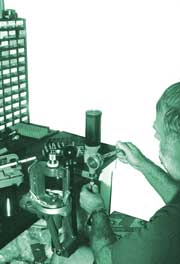
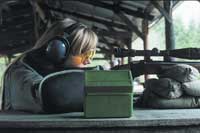
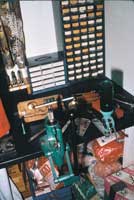 The first questions often asked by sportsmen thinking of reloading are: How much would it cost me to get started and how much can I expect to save by reloading my own cartridges? Unfortunately, these are extremely difficult questions to answer. As far as the initial cost, it simply depends on how elaborate the equipment you decide to purchase and how many calibres you intend to reload. There is always a range in pricing for all of the equipment and supplies. It is strictly up to you as to how elaborate (and costly) you want to get.
The first questions often asked by sportsmen thinking of reloading are: How much would it cost me to get started and how much can I expect to save by reloading my own cartridges? Unfortunately, these are extremely difficult questions to answer. As far as the initial cost, it simply depends on how elaborate the equipment you decide to purchase and how many calibres you intend to reload. There is always a range in pricing for all of the equipment and supplies. It is strictly up to you as to how elaborate (and costly) you want to get.
Necessary Equipment
At a minimum you will need a reloading press. Most individuals opt to purchase a lesser expensive, single-stage press over that of the faster and more expensive, progressive units. Single-stage presses may be a bit slower, but they do an excellent job. In addition, a set of reloading dies will be needed for each calibre you intend to load, as well as a shell holder. Each shell holder generally will fit several different calibres. Carbide dies are a good choice, but they will cost you quite a bit more than the standard steel dies. Unless you are intending to do a tremendous amount of reloading in one particular calibre, the less expensive steel dies will probably do you nicely.
You will have to have reloading data or ‘recipes’ as they are sometimes called. You can purchase manuals from many different sources, but you can also obtain free data from many powder manufacturers.
Many of the larger manuals serve a dual purpose. Not only do they provide you with the recipes to load by, in many cases they are also a great source of basic reloading instructions. Therefore, purchasing a good manual is probably the best first step to reloading.
Another crucial item for the reloader is a balance or scale. This piece of equipment is necessary to weigh your powder charges. In addition, you will need a tube of brass lube, a powder funnel, a case trimmer for trimming your brass, a deburring tool and something to check the length of your brass. Brass stretches as it is shot and, consequently, this excess length must be occasionally trimmed in order to keep the brass within acceptable safety limits. There are two common tools used for checking brass length: 1) a micrometer that actually measures the length in inches and/or millimetres and 2) a somewhat inexpensive and simple to use tool called a shell length gauge. The shell length gauge is simply a template device that you slide the brass into. If it slides between the two surfaces, the brass length falls within the acceptable limits. If it does not, the brass is too long and must be trimmed before being reloaded.
In addition to this basic equipment, you will need a place to work. A good solid working surface is imperative. A workbench or solid desk will do nicely. It should be located in an area having few distractions. Distractions can result in errors and errors can result in safety issues.
As alluded to earlier, the preliminary cost of setting yourself up for reloading can sometimes make a person swallow hard. There is one way that you may be able to save yourself some money initially and that is by purchasing a package deal. Some companies offer a kit containing all that is necessary to get started reloading, in a single box, for a single price. Generally, the total price of these package deals is less than if you purchased each item separately. It should be pointed out, however, that sometimes these kits do contain items that, while nice to have, may not be a requirement to get you reloading. Consequently, you should enter into these purchases carefully by evaluating whether they best fit your overall objectives and budget.
Once the basic requirements have been purchased, all you will need to load a different calibre is a set of reloading dies and the appropriate shell holder. Of course different calibres sometimes call for different bullets, powder and primers.
Optional Equipment
There are a lot of other tools and equipment that can be added to your reloading bench as time goes on. These are not a requirement in order to get started, but many of them make the reloading process easier, quicker and even more fun. A powder measure certainly falls into this category. These devices allow you to measure the powder charge quickly and easily in volumetric form. It is highly recommended; however, even when a powder measure is used, it should always be used in conjunction with a balance or powder scale. In most cases, particularly when loading coarse grained, slow burning rifle powders, charges can vary a few tenths of a grain when measured by volume. For this reason it is important that each charge be checked and adjusted accordingly with the use of a scale or balance. By doing so it will go a long way towards the best possible shooting accuracy and the greatest degree of reloading safety.
Another great device is a brass tumbler or polisher. When you polish your brass, you get a feeling of pride of ownership and accomplishment, just as you do after washing and waxing your car. A tumbler is great for keeping your brass pretty and free of corrosion. If you are looking to save money, however, you can polish the brass by hand with a can of brass cleaner or with a piece of steel wool.
Other tools that are handy are such things as primer pocket cleaners and case neck brushes, primer pocket reamers, bullet pullers, inside and outside neck turning devices and attachments, brass lubricating devices, powder dribblers, cartridge racks or loading blocks and automatic priming tools. These can be added at your leisure - or not.
Just how much you will be able to save on
the cost of ammunition when you reload will depend on a number of things.
Certainly, the more you reload, the more you will save. But a very big
factor in cost savings has to do with the volume of reloading supplies
you purchase at a time. There is often a considerable price break when
purchasing bullets in quantities of 500 or 1000 versus a box of 50 or
100, primers in quantities of 1000 or more versus 100, powder by the keg
rather than by the one-pound or one-kilogram can and brass by the 100,
500 or 1000. In addition, you will find a considerable variation in price
from one supplier to another, so the key is to shop around. A very rough
calculation based on advertised average component costs (assuming you
have had the foresight to save your spent brass) runs something like this
for a standard .243 load:
• Bullet - $0.30
• Primer - $0.05
• Powder - $0.19
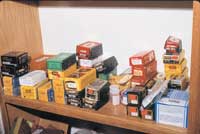
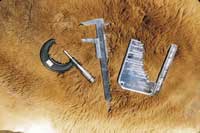
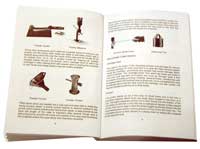 This would generate a price of $0.54/round
or $54/100. These figures are provided only in an effort to furnish a
very general idea of costs. As indicated earlier, there are many factors
that will come into play when figuring component costs. By shopping around,
you would probably be able to load the example .243 for even less than
these figures indicate or if you opt to load a premium bullet, it can
cost you more. It’s strictly based on your bargain shopping abilities
and your preferences in quality.
This would generate a price of $0.54/round
or $54/100. These figures are provided only in an effort to furnish a
very general idea of costs. As indicated earlier, there are many factors
that will come into play when figuring component costs. By shopping around,
you would probably be able to load the example .243 for even less than
these figures indicate or if you opt to load a premium bullet, it can
cost you more. It’s strictly based on your bargain shopping abilities
and your preferences in quality.
If you are looking for additional savings, why not take advantage of the cost breaks associated with buying in volume by splitting the purchase with a mate who uses the same size and weight bullets, the same powder, primers, etc? By doing so, both of you will save a great deal over buying in small components.
Handloaded ammunition has several very distinct benefits over factory-loaded cartridges. While it is the goal of every ammunition manufacturer to produce the best possible ammunition for the cost, they must consider a number of factors that can and do restrict your down-range performance. Cost of components is certainly one of those factors. Sometimes this means the factory may be loading a bullet that will not perform to the same standards that a high-quality hunting bullet would. Some manufacturers are now producing their ammunition using quality hunting bullets, but this ammunition can be expensive, limited to certain calibres and bullet weights and can be hard to find at times. The handloader on the other hand has a much greater selection available to them.
Another disadvantage to shooting factory-loaded shells is directly related to the company’s attempts at safety. Not all firearms are created equal in the arena of safety. While there are a lot of new, very strong and safe firearms in use today, there are also some older, marginally safe guns still being fired as well. The dilemma for the ammunition manufacturers is to produce a product that will be safe for a diverse range of firearms. Even though there are always the safety warnings on the box to use their ammunition only in firearms in good condition, the desire is always present to keep pressures down to an absolute minimum by the factory.
What this can mean to the shooter is a cartridge that does not always perform up to the potential of the particular calibre and gun. On the other hand, a careful reloader can work their loads up to take full advantage of the available potential. This may mean a substantial increase in velocity and energy over that produced by the factory-loaded ammunition. Some experienced shooters prefer to push their cartridges to near maximum limits, then back off until they obtain the best accuracy. Reloading allows the shooter to do this; factory ammunition does not.
If you shoot a rifle that generates a lot of recoil, you know just how hard it can be on your shoulder. If you reload your own ammunition, you may be able to ‘load down’ your cartridges to produce a softer recoil level. But a word of caution is in order here. No shooter should ever deviate from standard, published and tested reloading data. You might think that reducing the powder level in a cartridge will always produce less pressure, but this is not always the case. Experimentation in the area of powder volumes beyond what is recommended is never wise in reloading.
Dangerously high chamber pressures can sometimes be generated, particularly in magnum cartridges, if the powder level is reduced to below the recommended standards.
I have loaded my own rifle, pistol and shotgun ammunition for more than 30 years. Throughout that time I have fired virtually hundreds of thousands of rounds in every shooting endeavour imaginable. In many cases these rounds cost less, yet were superior to those produced by some obscure factory worker with no interest whatsoever in shooting. You too can do the same.
Certainly handloading does have its drawbacks, but loading your own ammunition is a bit like the bird hunter who hunts over a dog that he trained himself. The satisfaction of seeing his dog staunchly on point increases the enjoyment of the hunt at least a hundred-fold. A similar feeling of contentment, accomplishment, satisfaction and achievement is experienced when you know your handload was responsible for putting that trophy animal on the ground.
